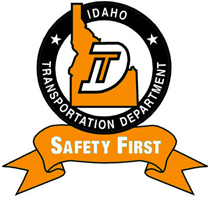
District 3 team explores ways of improving employee safety;
Accident Reduction Committee meets to organize policy changes
Like golf, your ranking on the ITD crash list is one of the places where a lower score is much better.
During the last fiscal year, District 3 had 28 injury accidents and 47 vehicle accidents. This fall, an internal team set out to remedy that by creating a district-wide accident reduction committee, headed by district safety/training manager Terry Meiners.
 The committee is composed of Special Crew Chief Dave Dansereau, Mountain Home Foreman Dave Labar, Resident Engineer Daris Bruce, Maintenance Supervisor Dan Bryant, and Traffic’s Gail Newlun. The committee met for the first time Nov. 15, with a follow-up slated for this week.
The committee is composed of Special Crew Chief Dave Dansereau, Mountain Home Foreman Dave Labar, Resident Engineer Daris Bruce, Maintenance Supervisor Dan Bryant, and Traffic’s Gail Newlun. The committee met for the first time Nov. 15, with a follow-up slated for this week.
While it is definitely true that District 3 has a higher rate of opportunity - number of employees multiplied by amount of exposure - the district’s rate of incident raised some eyebrows within the organization. District Engineer Dave Jones declared it unacceptable to continue in the same manner.
In the latest quarterly report, half of the incidents by District 3 were the result of a state-owned vehicle or a piece of equipment striking another vehicle or obstacle.
District 3 reported 13 vehicle accidents and three employee-injury accidents in that time. Many incidents were a direct result of employee inattentiveness and can be resolved with greater vigilance.
The district already has a template to follow. In recent years, districts 5 and 6 worked on Accident Classification Systems to assist their employee safety committees in evaluating accidents in the areas of negligence, severity, and other factors contributing to incidents. The D-5 and D-6 committees then suggested disciplinary actions or other methods to mitigate the behavior.
That system, and the consequences, were tied to the old Performance Management Plan.
Wayne Curtis, who was the Employee Safety/Training (EST) manager with District 5 when it implemented its program, had this advice:
-
Report all accidents and near-misses. Be vigilant on that!
-
Investigate every incident/accident, but be fair and keep in mind that some incidents are the cost of doing business.
-
Become familiar with each area to keep open lines of communication.
-
And finally, get upper management involved and gain their very strong support. When a policy is delivered by the district engineer, that is very impactful.
Published 12-17-2010